Explaining the world one sketch at a time
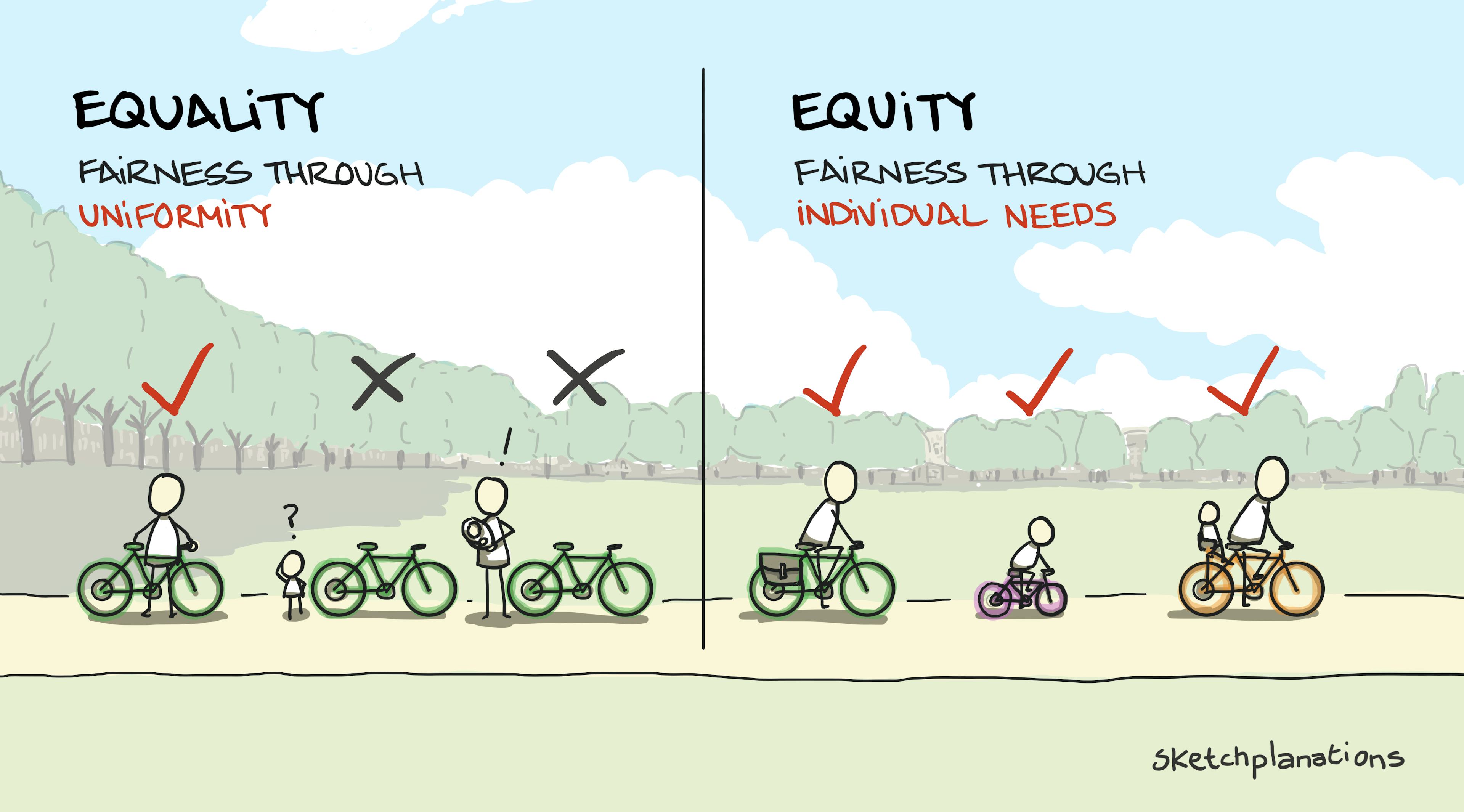
Equality and equity
Equality and equity are two important ideas that help us understand how to make things fair for everyone. Here's one way that helps me think about the difference between equity and equality: Equality is fairness through uniformity, and equity is fairness through a recognition of individual needs. If everyone gets the same—equality—this is fairer than some people getting something and others nothing. However, if a group were to go bike riding, as in the sketch, if everyone had the same bike, then it might work well for one person but not fit at all for a child or a shorter person. And if you had extra gear, young children to handle, or a disability, getting the same bike might not work at all. In contrast, equity considers each person's individual needs to give everyone the same opportunity. Since getting the same bike doesn't meet everyone's needs, this might involve getting a bike that is the right height, or has a child seat to allow a parent and child to ride together, or other adaptations to accommodate someone with a disability. This way, everyone can ride comfortably and safely. Equity is about understanding that everyone has different needs and making sure those needs are met so that everyone has a fair chance to succeed. Thinking about it this way helped me understand the difference between equality and equity, two concepts I had never clearly distinguished. By focusing on equity, we can ensure that everyone has the support they need to do their best, even if it means giving different kinds of help to different people. I don't consider myself an expert on this topic, so I'd be happy to receive guidance or links to articles for further education if you have them. Also see: the curb-cut effect, one-size-fits-men, how to draw a bike…Equality and equity are two important ideas that help us understand how to make things fair for everyone. Here's one way that helps me think about the difference between equity and equality: Equality is fairness through uniformity, and equity is fairness through a recognition of individual needs. If everyone gets the same—equality—this is fairer than some people getting something and others nothing. However, if a group were to go bike riding, as in the sketch, if everyone had the same bike, then it might work well for one person but not fit at all for a child or a shorter person. And if you had extra gear, young children to handle, or a disability, getting the same bike might not work at all. In contrast, equity considers each person's individual needs to give everyone the same opportunity. Since getting the same bike doesn't meet everyone's needs, this might involve getting a bike that is the right height, or has a child seat to allow a parent and child to ride together, or other adaptations to accommodate someone with a disability. This way, everyone can ride comfortably and safely. Equity is about understanding that everyone has different needs and making sure those needs are met so that everyone has a fair chance to succeed. Thinking about it this way helped me understand the difference between equality and equity, two concepts I had never clearly distinguished. By focusing on equity, we can ensure that everyone has the support they need to do their best, even if it means giving different kinds of help to different people. I don't consider myself an expert on this topic, so I'd be happy to receive guidance or links to articles for further education if you have them. Also see: the curb-cut effect, one-size-fits-men, how to draw a bikeWWW…
Read more…
Public commitment pledge
Public commitment pledges are a surprisingly effective and free way to help you reach your goals. A public commitment pledge is simply writing what you will or won't do, perhaps something you know you find hard, signing it and displaying it publicly. In her excellent book, How to Change, Katy Milkman describes how the simple intervention of a public commitment pledge in doctors' offices significantly reduced prescriptions of unnecessary antibiotics—just through a poster on the wall. Commitment pledges are a form of what Katy calls a soft commitment device (of Odysseus fame). This strategy helps us stick to our commitments even when tempted to go astray. Pledges may work through our desire for consistency and create cognitive dissonance when considering going against the pledge. The benefits of what we desire to do, say "eat cookies," are pitted against the potential guilt or discomfort we'd feel by going against what we said we'd do, not "eat cookies." You don't want to let yourself down. The pledge gives us a greater chance of sticking to our actions and a defence against our present bias. Is there something you wish you'd do more of or less of? A simple public commitment pledge could help you on your way. Other free ways to help you achieve your goals: Temptation bundling, The Fresh Start Effect, commitment device, Nine-enders, Implementation intentions…Public commitment pledges are a surprisingly effective and free way to help you reach your goals. A public commitment pledge is simply writing what you will or won't do, perhaps something you know you find hard, signing it and displaying it publicly. In her excellent book, How to Change, Katy Milkman describes how the simple intervention of a public commitment pledge in doctors' offices significantly reduced prescriptions of unnecessary antibiotics—just through a poster on the wall. Commitment pledges are a form of what Katy calls a soft commitment device (of Odysseus fame). This strategy helps us stick to our commitments even when tempted to go astray. Pledges may work through our desire for consistency and create cognitive dissonance when considering going against the pledge. The benefits of what we desire to do, say "eat cookies," are pitted against the potential guilt or discomfort we'd feel by going against what we said we'd do, not "eat cookies." You don't want to let yourself down. The pledge gives us a greater chance of sticking to our actions and a defence against our present bias. Is there something you wish you'd do more of or less of? A simple public commitment pledge could help you on your way. Other free ways to help you achieve your goals: Temptation bundling, The Fresh Start Effect, commitment device, Nine-enders, Implementation intentionsWWW…
Read more…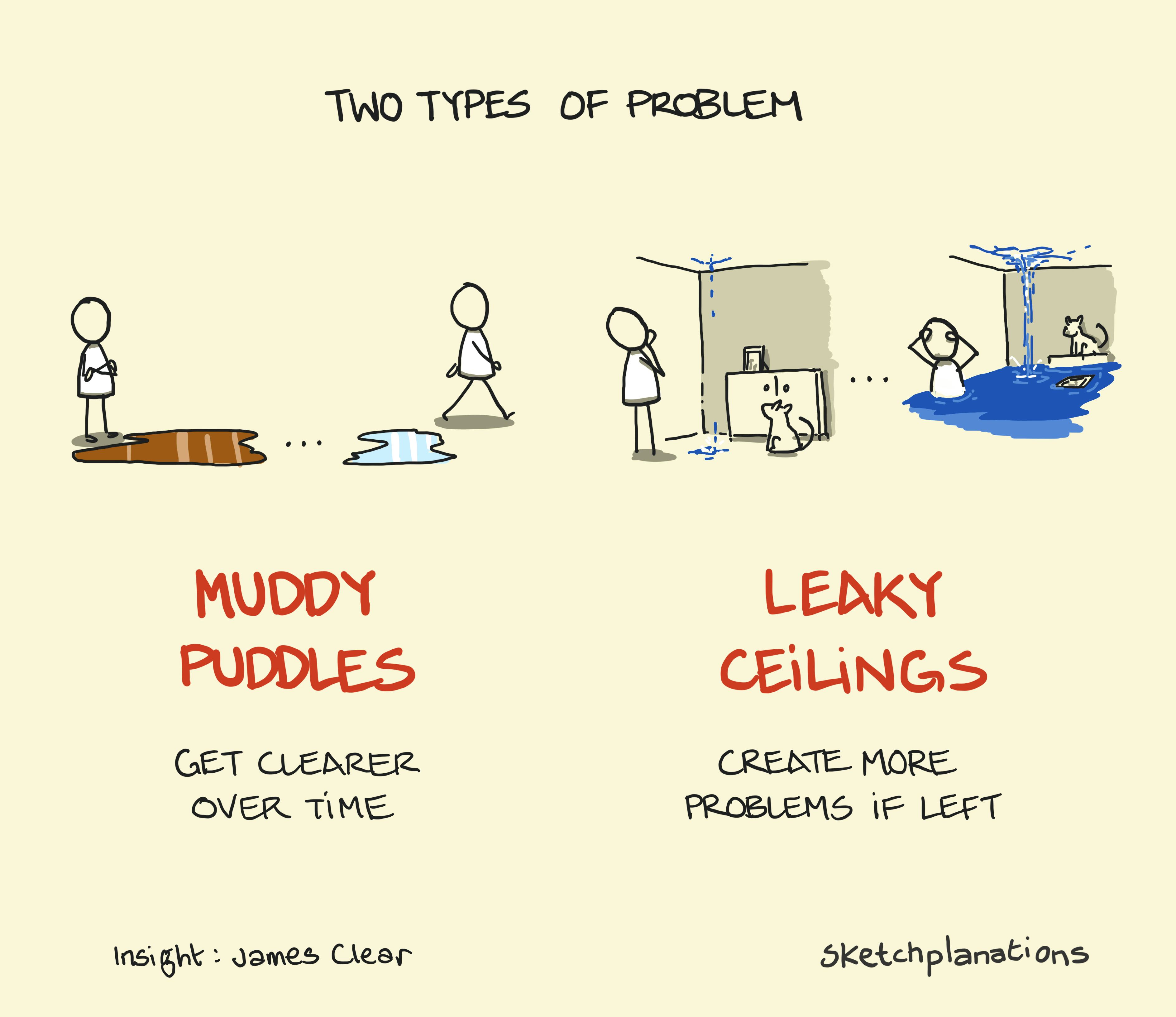
Muddy puddles, leaky ceilings
What type of problem are you dealing with? James Clear shared a technique of splitting problems into two types: muddy puddles or leaky ceilings. A muddy puddle problem is one where leaving it alone can help to make it clearer. A leaky ceiling problem is one where leaving it alone causes more problems. Leaky ceilings need resolving soon. Muddy puddles can be left until they are clearer. Here's James Clear explaining it in his own words: "I split problems into two groups: muddy puddles and leaky ceilings. Some problems are like muddy puddles. The way to clear a muddy puddle is to leave it alone. The more you mess with it, the muddier it becomes. Many of the problems I dream up when I'm overthinking or worrying or ruminating fall into this category. Is life really falling apart or am I just in a sour mood? Is this as hard as I'm making it or do I just need to go workout? Drink some water. Go for a walk. Get some sleep. Go do something else and give the puddle time to turn clear. Other problems are like a leaky ceiling. Ignore a small leak and it will always widen. Relationship tension that goes unaddressed. Overspending that becomes a habit. One missed workout drifting into months of inactivity. Some problems multiply when left unattended. You need to intervene now. Are you dealing with a leak or a puddle?" Also see: lateral thinking sketches, The XY Problem, Point Positive, Solvitur Ambulando…What type of problem are you dealing with? James Clear shared a technique of splitting problems into two types: muddy puddles or leaky ceilings. A muddy puddle problem is one where leaving it alone can help to make it clearer. A leaky ceiling problem is one where leaving it alone causes more problems. Leaky ceilings need resolving soon. Muddy puddles can be left until they are clearer. Here's James Clear explaining it in his own words: "I split problems into two groups: muddy puddles and leaky ceilings. Some problems are like muddy puddles. The way to clear a muddy puddle is to leave it alone. The more you mess with it, the muddier it becomes. Many of the problems I dream up when I'm overthinking or worrying or ruminating fall into this category. Is life really falling apart or am I just in a sour mood? Is this as hard as I'm making it or do I just need to go workout? Drink some water. Go for a walk. Get some sleep. Go do something else and give the puddle time to turn clear. Other problems are like a leaky ceiling. Ignore a small leak and it will always widen. Relationship tension that goes unaddressed. Overspending that becomes a habit. One missed workout drifting into months of inactivity. Some problems multiply when left unattended. You need to intervene now. Are you dealing with a leak or a puddle?" Also see: lateral thinking sketches, The XY Problem, Point Positive, Solvitur AmbulandoWWW…
Read more…
Rose, Thorn, Bud
Rose, thorn, bud is a simple tool for reflection for yourself or your team. The basic idea is to look back at a recent project or how things are going and consider each aspect of a rose: Rose: what are the successes? What's gone well? Thorn: what are the challenges? What could we do better? Bud: what are opportunities with potential? What could we explore or try? If running as a team retro activity or retrospective, you might spend a few minutes individually adding thoughts for each prompt, then talk through each of the thoughts in Rose, Thorn and Bud. A separate but no less important step is often to capture actions from the reflection—what you'll do as a result. If you're conducting retros regularly, consider revisiting actions from previous sessions. I like "rose, thorn, bud" as it's beautiful to consider that a rose contains such different facets, like so many things. I've come across many retro and reflection activities that are variations of these three prompts: "What went well?", "What didn't go well?" and "What else?" A few to mention: The sailboat retro: Goal/vision, Rocks, Wind, Anchor — a nice feature for a team is that this activity places you all in the same boat Glad, Mad, Sad Liked, Learned, Lacked, Longed for Wishes, Risks, Appreciations, Puzzles I liked, I wish, What if Start, stop, continue Strengths, Weaknesses, Opportunities, Threats (SWOT) A reader suggested a fourth aspect of the rose analogy to reflect on as its leaves or roots: what are the unnoticed or behind-the-scenes things that contribute to the rose's success? I've come to consider that it doesn't matter too much what activity you choose to get a discussion going. What matters most is regular reflection, hearing all the voices in a team, and making progress together. One teammate ran an excellent retro by us all finishing early and heading to the pub. I didn't intend it, but some of the products and prints for rose, thorn, bud out to be some of the nicest I have. Also see: Information radiator, MoSCoW prioritisation, RACI, How to peel a Post-it so it doesn't fall down, the upward spiral…Rose, thorn, bud is a simple tool for reflection for yourself or your team. The basic idea is to look back at a recent project or how things are going and consider each aspect of a rose: Rose: what are the successes? What's gone well? Thorn: what are the challenges? What could we do better? Bud: what are opportunities with potential? What could we explore or try? If running as a team retro activity or retrospective, you might spend a few minutes individually adding thoughts for each prompt, then talk through each of the thoughts in Rose, Thorn and Bud. A separate but no less important step is often to capture actions from the reflection—what you'll do as a result. If you're conducting retros regularly, consider revisiting actions from previous sessions. I like "rose, thorn, bud" as it's beautiful to consider that a rose contains such different facets, like so many things. I've come across many retro and reflection activities that are variations of these three prompts: "What went well?", "What didn't go well?" and "What else?" A few to mention: The sailboat retro: Goal/vision, Rocks, Wind, Anchor — a nice feature for a team is that this activity places you all in the same boat Glad, Mad, Sad Liked, Learned, Lacked, Longed for Wishes, Risks, Appreciations, Puzzles I liked, I wish, What if Start, stop, continue Strengths, Weaknesses, Opportunities, Threats (SWOT) A reader suggested a fourth aspect of the rose analogy to reflect on as its leaves or roots: what are the unnoticed or behind-the-scenes things that contribute to the rose's success? I've come to consider that it doesn't matter too much what activity you choose to get a discussion going. What matters most is regular reflection, hearing all the voices in a team, and making progress together. One teammate ran an excellent retro by us all finishing early and heading to the pub. I didn't intend it, but some of the products and prints for rose, thorn, bud out to be some of the nicest I have. Also see: Information radiator, MoSCoW prioritisation, RACI, How to peel a Post-it so it doesn't fall down, the upward spiralWWW…
Read more…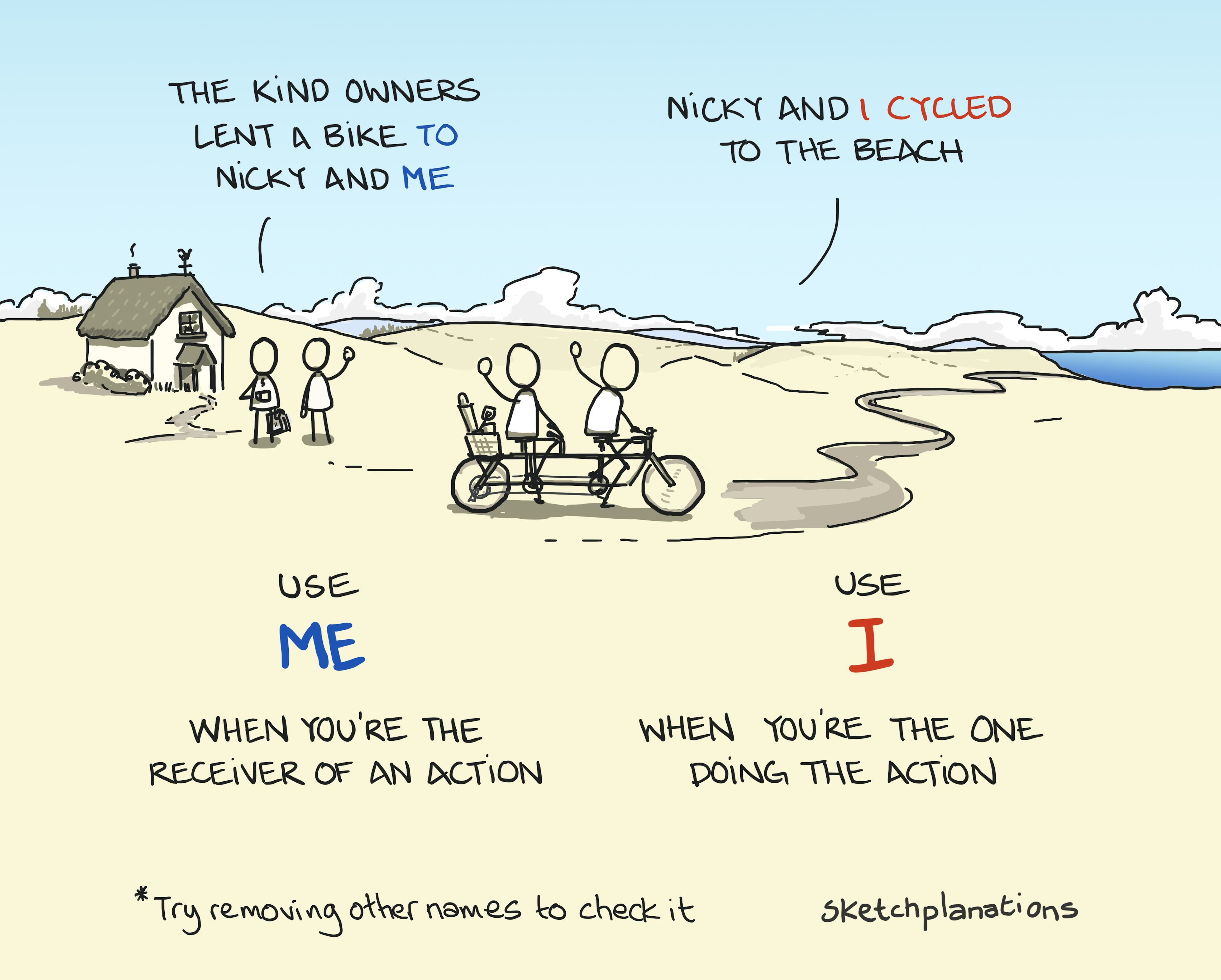
Me or I
In a list of names, when should you use "I", and when should you use "Me"? I confess to having blundered my way through whether it should be Rob, Tom, and I on the podcast, or a podcast with Rob, Tom and me. In other words, in a list of names, of which I am one, should I be using "I" or should I be using "Me"? A general rule to help you know which to use when is to remember that if an action is being done to or for you, then use "me." Here, you're the object of the sentence. If it's you doing the action, then use "I." In this case, you're the subject of the sentence. So, in the example in the sketch, the kind owners of the cottage are lending the bike to us both—I'm not the one doing the lending but instead am receiving the bike—so it should be: "The kind owners lent a bike to Nicky and me." Conversely, when we cycle off, it's both of us doing the cycling, so here it should be: "Nicky and I cycled to the beach." To be sure you're nailing it, try removing other names from the list. Often, it makes it obvious which to use. For example, when phrased as "The kind owners lent a bike to I," and "Me cycled to the beach," it's pretty straightforward which is right or wrong. Also see: Affect effect, less fewer, tandem, by monkeys, Oxford commas…In a list of names, when should you use "I", and when should you use "Me"? I confess to having blundered my way through whether it should be Rob, Tom, and I on the podcast, or a podcast with Rob, Tom and me. In other words, in a list of names, of which I am one, should I be using "I" or should I be using "Me"? A general rule to help you know which to use when is to remember that if an action is being done to or for you, then use "me." Here, you're the object of the sentence. If it's you doing the action, then use "I." In this case, you're the subject of the sentence. So, in the example in the sketch, the kind owners of the cottage are lending the bike to us both—I'm not the one doing the lending but instead am receiving the bike—so it should be: "The kind owners lent a bike to Nicky and me." Conversely, when we cycle off, it's both of us doing the cycling, so here it should be: "Nicky and I cycled to the beach." To be sure you're nailing it, try removing other names from the list. Often, it makes it obvious which to use. For example, when phrased as "The kind owners lent a bike to I," and "Me cycled to the beach," it's pretty straightforward which is right or wrong. Also see: Affect effect, less fewer, tandem, by monkeys, Oxford commasWWW…
Read more…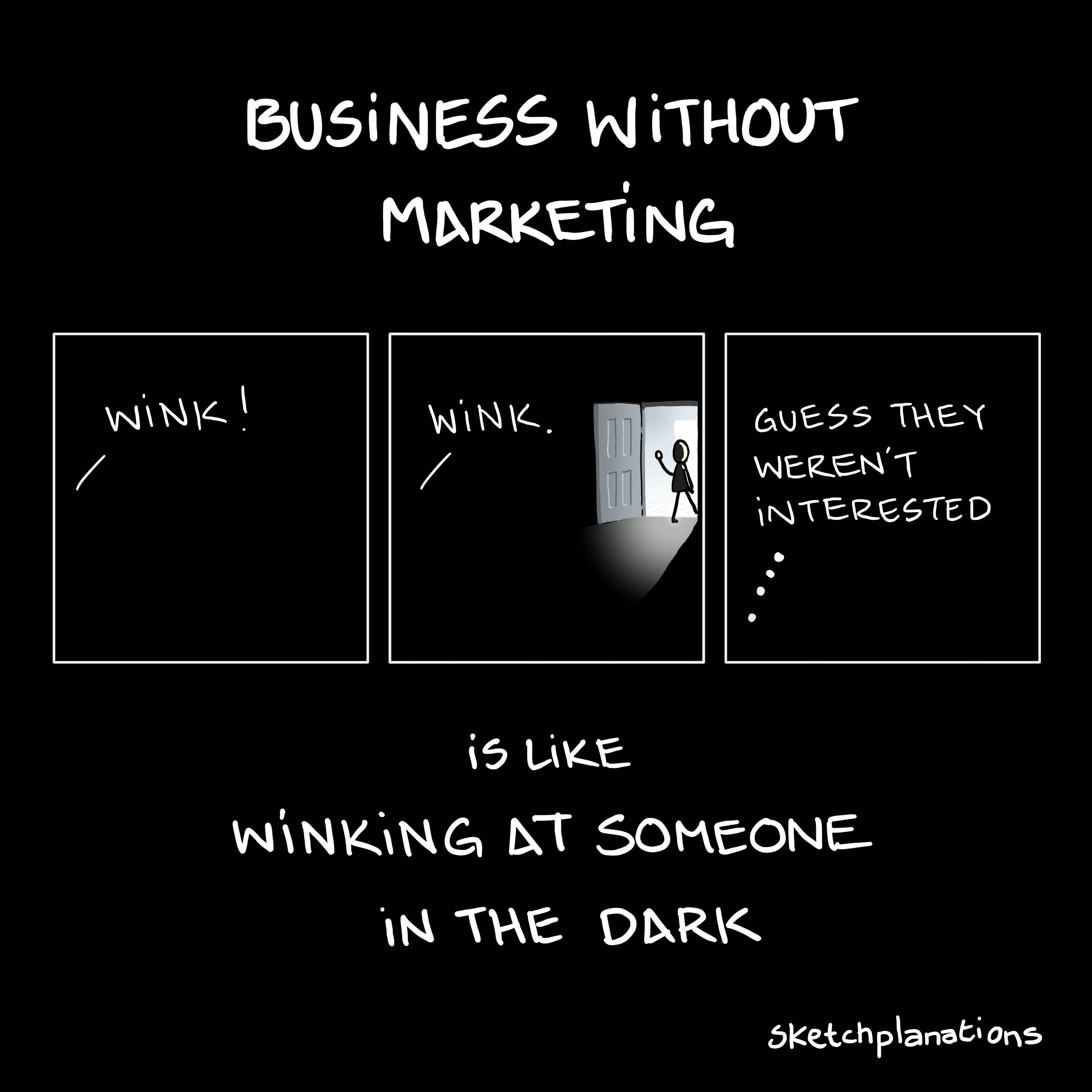
Winking in the dark
An often-quoted adage goes: Doing business without marketing is like winking at a girl in the dark. You know what you're doing, but no one else does. As someone with a background in product development and engineering, I've always cared more about the product than about letting people know that the product exists. But it's an uncomfortable truth that there's no point in having a better product if no one knows about it. More ventures have likely died from not reaching others than from having a lousy solution. This is also why great businesses are built by multi-disciplinary teams—it takes many complementary skills to make a great product succeed. I think the phrase "Build a better mousetrap, and the world will beat a path to your door" is rarely true. Along these lines, if you can think of others who'd find Sketchplanations helpful or who might like my book Big Ideas Little Pictures, please consider sending on a link or your favourite sketch. After all, business without marketing... ;o) The quote is usually attributed with "advertising" instead of "marketing" to Steuart Henderson Britt, a marketing professor and psychologist at Northwestern University. But I couldn't find any verifiable source of the quote to him on the internet, and I prefer it with the more generally applicable marketing, so I went with that. If you know of a trustworthy source for the quote, please let me know! Also see: The rule of 7, the business flywheel…An often-quoted adage goes: Doing business without marketing is like winking at a girl in the dark. You know what you're doing, but no one else does. As someone with a background in product development and engineering, I've always cared more about the product than about letting people know that the product exists. But it's an uncomfortable truth that there's no point in having a better product if no one knows about it. More ventures have likely died from not reaching others than from having a lousy solution. This is also why great businesses are built by multi-disciplinary teams—it takes many complementary skills to make a great product succeed. I think the phrase "Build a better mousetrap, and the world will beat a path to your door" is rarely true. Along these lines, if you can think of others who'd find Sketchplanations helpful or who might like my book Big Ideas Little Pictures, please consider sending on a link or your favourite sketch. After all, business without marketing... ;o) The quote is usually attributed with "advertising" instead of "marketing" to Steuart Henderson Britt, a marketing professor and psychologist at Northwestern University. But I couldn't find any verifiable source of the quote to him on the internet, and I prefer it with the more generally applicable marketing, so I went with that. If you know of a trustworthy source for the quote, please let me know! Also see: The rule of 7, the business flywheelWWW…
Read more…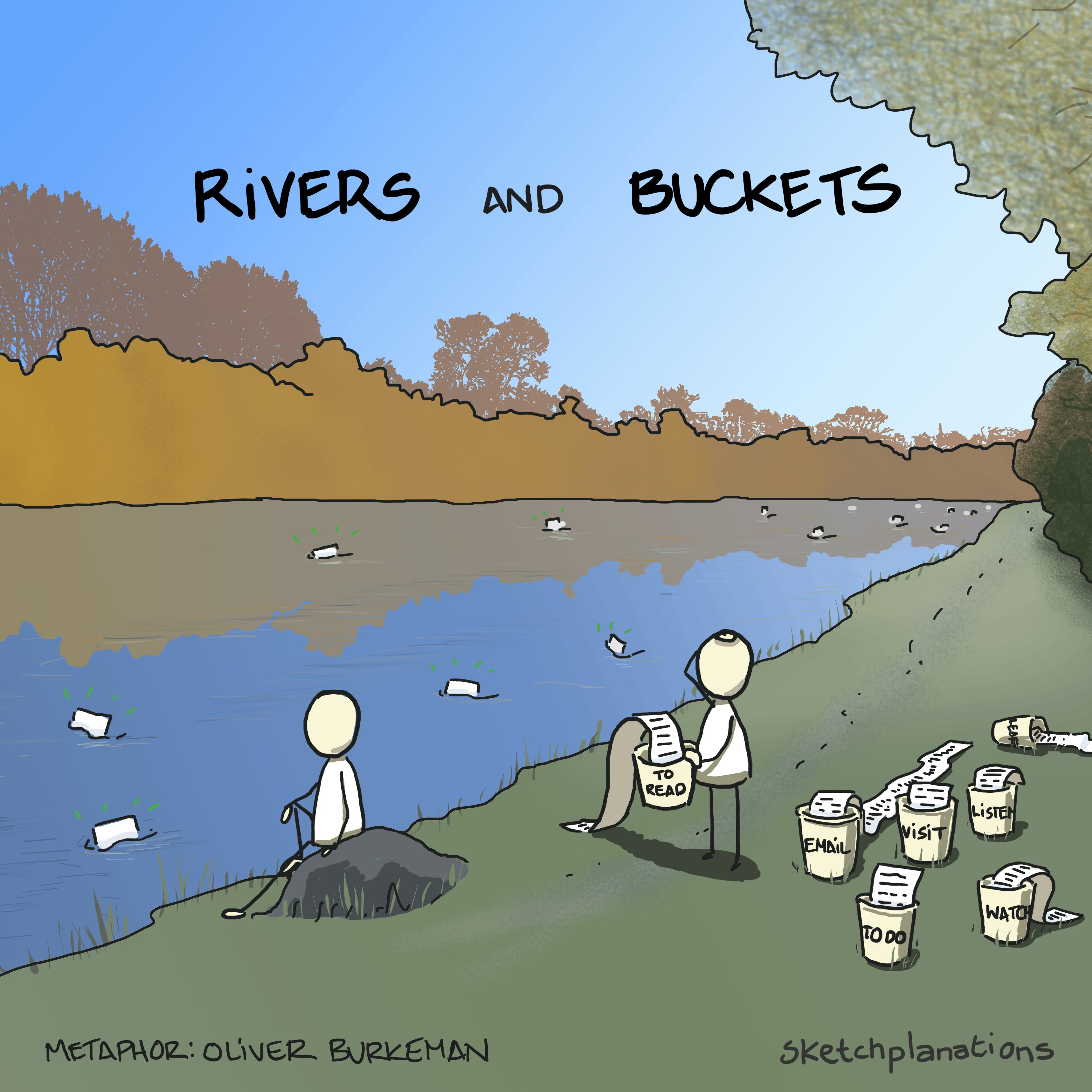
Rivers and buckets
Too many interesting articles to read? Too many places to visit? Too many projects to work on? Too many podcasts to listen to? Too many interesting things to learn? Try thinking of each as rivers, not buckets. Oliver Burkeman shared a beautiful and powerful metaphor to reframe the bucket list of everything we want to do but can't possibly get done. There's an endless stream of books to read, programs to watch, and things you may want to get done. Instead of a bucket list to get through, try thinking of it as a river where attractive options drift by. Rather than feeling pressure to clear out the bucket or tick off all the items, instead, you can choose from the river what interests you in the knowledge that more will always come along. This reframing resonated with me when I considered everything I wanted to read or the emails in my inbox. When you have too many emails, you find you answer the ones that really need answering. There will always be more. Growing up with a scarcity mindset regarding photos, I used to carefully trim each photo I didn't want after a weekend away or travelling. It was a revelation to me to consider selecting the ones I liked instead of worrying about removing every one that I didn't. Maybe you do have to get through everything at work, but this mindset doesn't need to apply to your personal life. Don't beat yourself up. It's impossible to keep up with everything. Consider thinking of areas of your life like rivers, not buckets. Oliver explains rivers not buckets in "Treat your to-read pile like a river". Or listen to Oliver reading the short essay in the Waking Up app. Also see: The four pillars of too much, Lifetime reads, Tsundoku…Too many interesting articles to read? Too many places to visit? Too many projects to work on? Too many podcasts to listen to? Too many interesting things to learn? Try thinking of each as rivers, not buckets. Oliver Burkeman shared a beautiful and powerful metaphor to reframe the bucket list of everything we want to do but can't possibly get done. There's an endless stream of books to read, programs to watch, and things you may want to get done. Instead of a bucket list to get through, try thinking of it as a river where attractive options drift by. Rather than feeling pressure to clear out the bucket or tick off all the items, instead, you can choose from the river what interests you in the knowledge that more will always come along. This reframing resonated with me when I considered everything I wanted to read or the emails in my inbox. When you have too many emails, you find you answer the ones that really need answering. There will always be more. Growing up with a scarcity mindset regarding photos, I used to carefully trim each photo I didn't want after a weekend away or travelling. It was a revelation to me to consider selecting the ones I liked instead of worrying about removing every one that I didn't. Maybe you do have to get through everything at work, but this mindset doesn't need to apply to your personal life. Don't beat yourself up. It's impossible to keep up with everything. Consider thinking of areas of your life like rivers, not buckets. Oliver explains rivers not buckets in "Treat your to-read pile like a river". Or listen to Oliver reading the short essay in the Waking Up app. Also see: The four pillars of too much, Lifetime reads, TsundokuWWW…
Read more…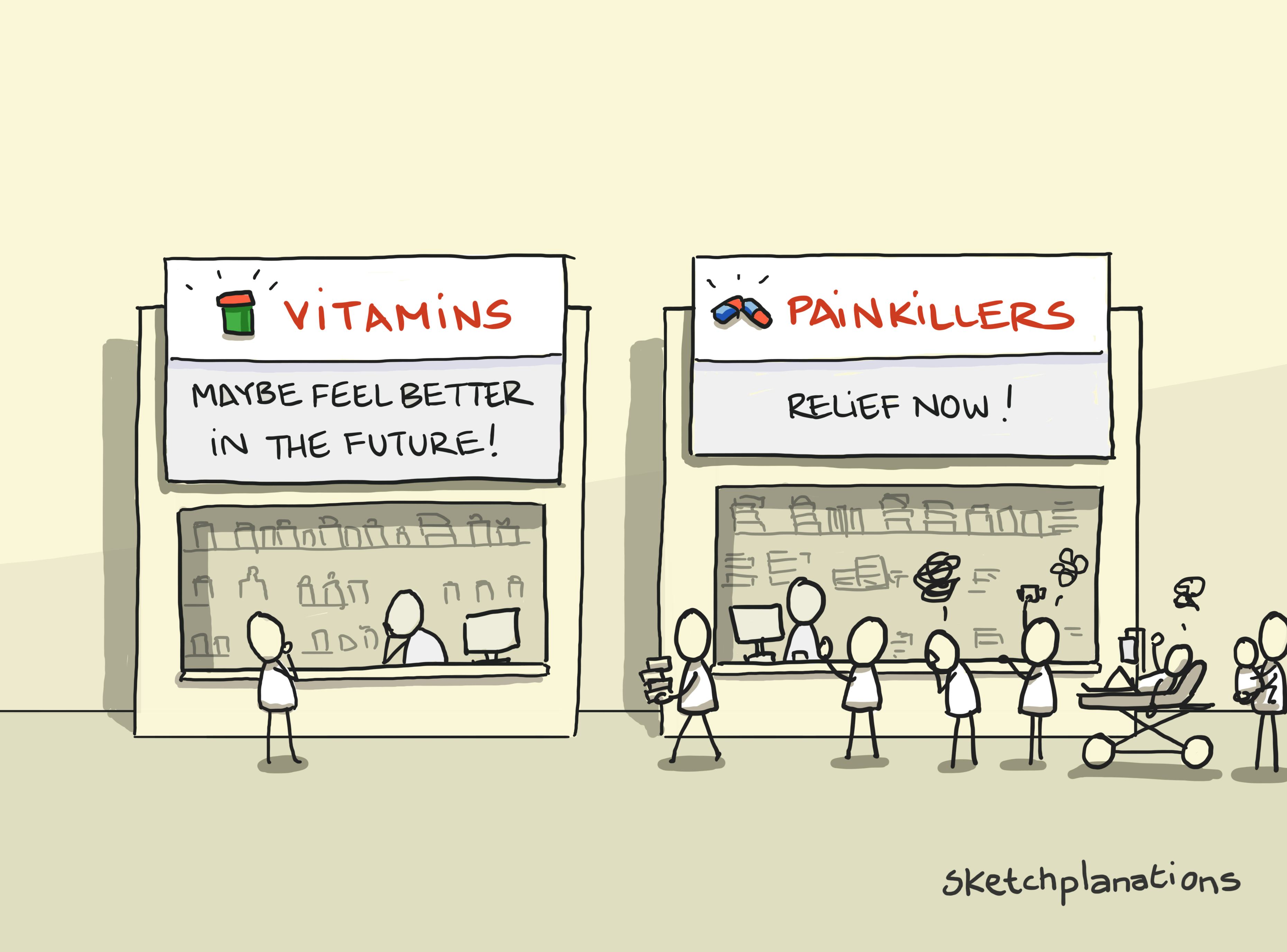
Painkillers and vitamins
Sell painkillers, not vitamins, the classic business advice goes. The vitamin seller aims to help you stay healthy in the long run— to help you avoid future pain and trial by keeping you clear of sickness. However, the painkiller seller has some advantages. If you're experiencing pain right now, a painkiller offers immediate relief. The benefit is instant and tangible. Unlike the vague and uncertain nature of future illnesses, pain is immediate and unmistakable. Knowing if a painkiller worked is easy, as the pain will disappear. It's hard to tell if a vitamin worked. If I don't get sick, was it the vitamins, my sleep, exercise, or, well, anything else that did it? This dynamic can lead to unfortunate consequences. We may prioritise our current needs over future well-being, such as fixing a broken car when it breaks rather than maintaining it. We need help saving money for the future. We tackle the "urgent" and neglect the "important-not urgent." We might overestimate the likelihood of making good choices in the future. In essence, it's easy to downplay future challenges compared to our current predicament. Some examples: implementing security measures vs. fixing bugs looking after your car vs. fixing your car when it breaks down doing daily exercises vs. going to the doctor when you're sick shopping and preparing food vs. ordering takeaway now making a product easier to use vs. making the product compliant preparing fruit to eat later vs. grabbing a cookie now insulating your house vs. putting the heating on now Some see business as selling candy, vitamins, and painkillers. Candy is a treat, but it's easy to live without. Vitamins promise to make life better, but you can do without them. Painkillers are must-haves as they solve an immediate, tangible need. Also see: present bias, tragedy of the commons, the dilution effect, the Shirky principle.…Sell painkillers, not vitamins, the classic business advice goes. The vitamin seller aims to help you stay healthy in the long run— to help you avoid future pain and trial by keeping you clear of sickness. However, the painkiller seller has some advantages. If you're experiencing pain right now, a painkiller offers immediate relief. The benefit is instant and tangible. Unlike the vague and uncertain nature of future illnesses, pain is immediate and unmistakable. Knowing if a painkiller worked is easy, as the pain will disappear. It's hard to tell if a vitamin worked. If I don't get sick, was it the vitamins, my sleep, exercise, or, well, anything else that did it? This dynamic can lead to unfortunate consequences. We may prioritise our current needs over future well-being, such as fixing a broken car when it breaks rather than maintaining it. We need help saving money for the future. We tackle the "urgent" and neglect the "important-not urgent." We might overestimate the likelihood of making good choices in the future. In essence, it's easy to downplay future challenges compared to our current predicament. Some examples: implementing security measures vs. fixing bugs looking after your car vs. fixing your car when it breaks down doing daily exercises vs. going to the doctor when you're sick shopping and preparing food vs. ordering takeaway now making a product easier to use vs. making the product compliant preparing fruit to eat later vs. grabbing a cookie now insulating your house vs. putting the heating on now Some see business as selling candy, vitamins, and painkillers. Candy is a treat, but it's easy to live without. Vitamins promise to make life better, but you can do without them. Painkillers are must-haves as they solve an immediate, tangible need. Also see: present bias, tragedy of the commons, the dilution effect, the Shirky principle.WWW…
Read more…Loading more…